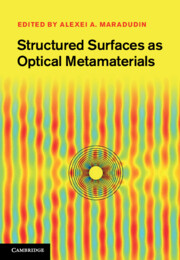Book contents
- Frontmatter
- Contents
- List of contributors
- Preface
- 1 Physics of extraordinary transmission through subwavelength hole arrays
- 2 Resonant optical properties of nanoporous metal surfaces
- 3 Optical wave interaction with two-dimensional arrays of plasmonic nanoparticles
- 4 Chirality and anisotropy of planar metamaterials
- 5 Novel optical devices using negative refraction of light by periodically corrugated surfaces
- 6 Transformation of optical fields by structured surfaces
- 7 Surface electromagnetic waves on structured perfectly conducting surfaces
- 8 Negative refraction using plasmonic structures that are atomically flat
- 9 Anomalous transmission in waveguides with correlated disorder in surface profiles
- 10 Cloaking
- 11 Linear and nonlinear phenomena with resonating surface polariton waves and their applications
- Index
- Plate section
- References
6 - Transformation of optical fields by structured surfaces
Published online by Cambridge University Press: 01 June 2011
- Frontmatter
- Contents
- List of contributors
- Preface
- 1 Physics of extraordinary transmission through subwavelength hole arrays
- 2 Resonant optical properties of nanoporous metal surfaces
- 3 Optical wave interaction with two-dimensional arrays of plasmonic nanoparticles
- 4 Chirality and anisotropy of planar metamaterials
- 5 Novel optical devices using negative refraction of light by periodically corrugated surfaces
- 6 Transformation of optical fields by structured surfaces
- 7 Surface electromagnetic waves on structured perfectly conducting surfaces
- 8 Negative refraction using plasmonic structures that are atomically flat
- 9 Anomalous transmission in waveguides with correlated disorder in surface profiles
- 10 Cloaking
- 11 Linear and nonlinear phenomena with resonating surface polariton waves and their applications
- Index
- Plate section
- References
Summary
Introduction
A reader of this book will quickly see that structured surfaces, whether deterministic or random, can reflect, transmit, refract, and amplify volume or surface electromagnetic waves in ways that naturally occurring surfaces cannot. They can also change the nature of an electromagnetic field incident on them. For example, they can change a beam with one intensity distribution into a beam with a different intensity distribution, or they can convert a plane wave into a beam. The use of structured surfaces, specifically randomly rough surfaces, to effect such transformations of optical fields is the subject of this chapter, where two examples of this use are presented, namely beam shaping and the formation of pseudo-nondiffracting beams.
The creation of optical elements that transform an electromagnetic beam with a specified transverse intensity distribution into a beam with a different specified transverse intensity distribution, especially those that transform a laser beam with a Gaussian intensity profile into a beam with a constant intensity profile – a flat top beam, has been studied theoretically and experimentally for many years [1–38]. The interest in beam shaping is due to a wide range of applications for beams with a variety of non-Gaussian intensity distributions. These applications include laser surgery [39], laser radar [40], laser microstructuring of materials [41], metal hardening [42], optical communication [43], and optical scanning [44], among others. Some of them and other applications of beam shaping are discussed in the recent book by Dickey et al. [45].
- Type
- Chapter
- Information
- Structured Surfaces as Optical Metamaterials , pp. 185 - 231Publisher: Cambridge University PressPrint publication year: 2011



